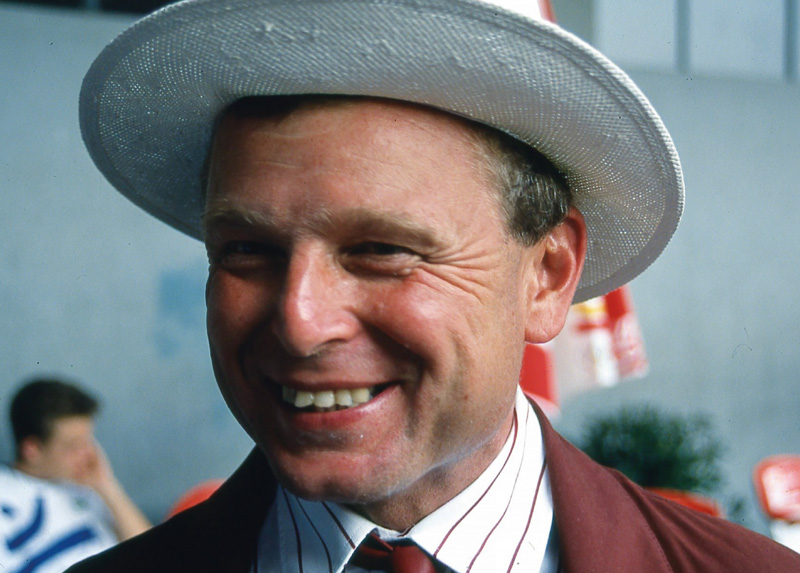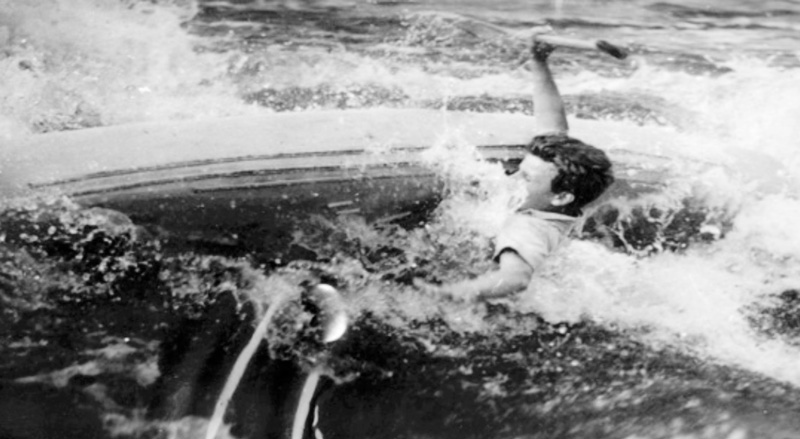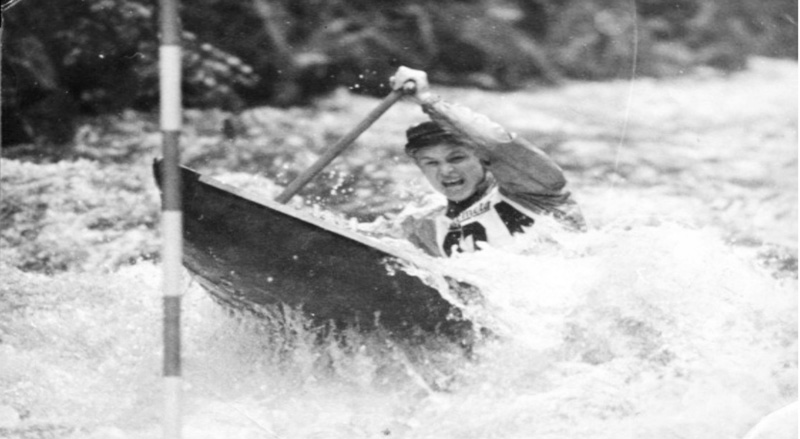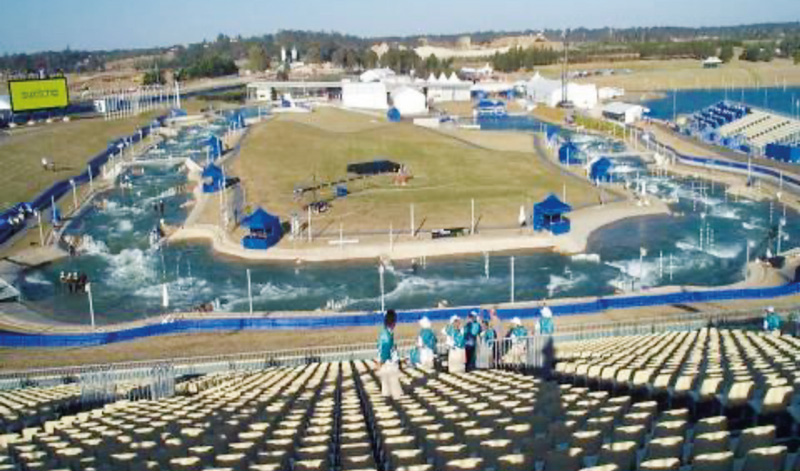 Jaroslav Pollert senior, Olympic Games Barcelona 1992, leader of the canoeist expedition
Jaroslav Pollert senior, Olympic Games Barcelona 1992, leader of the canoeist expedition
Do you remember the first time that water appealed to you so much that you decided to dedicate your professional and private life to it?
It is quite a difficult question. to say that the motive was building “dams” in the streams after the rain would probably be untrue. My interest in the field arose roughly at the moment when my brother, who was five years older, took me to the shipyard at the confluence of the Vltava and Čertovka rivers in Prague in 1957. The view from the shipyard over the river all the way to Vyšehrad was breath-taking. Just like the first descent of the Lower Sázava in the summer of 1957 with my brother on a double canoe during a minor flood, when the Vrané reservoir was also flowing, so we managed to reach the Malá Strana shipyard from Krhanice in one day. I made quite rapid progress in technical and competitive skills in water slalom, and so in 1959 I won the youth championship of Czechoslovakia both in single canoe and in kayak. Practical knowledge of the flow of water probably helped me to the fact that, after graduating from a secondary school, I agreed with my parents to go to an extension course at a technical school in Dušní street, majoring in water management. My parents didn‘t have an easy time with me. When I graduated from technical school, I resisted and didn‘t want to go to university. At that time, being a TV repairman was financially better than being an engineer. However, the fear of compulsory two-year military service and also my friends, almost all university students, changed my view of life, and I applied to CTU – water engineering and water management. In retrospect, I can say that I barely passed through secondary school, but finishing university on time was not a big problem, even though it was already connected with top-level sport.
 All beginnings are difficult – wild water was stronger, Staroměstský jez, Prague 1959
All beginnings are difficult – wild water was stronger, Staroměstský jez, Prague 1959
You have gained a lot of success in sport. Which do you value the most?
Sport taught me to understand one important thing: to be able to accept victories, but also defeats, and there are many more of them in life. This truth has also been transferred into professional life, as not every application for a new project or grant, for example, comes through. Those “unnecessary” pages of writing are a loss. But then comes the acceptance of a project – and that is victory. But the question is: sporting achievements. of course, these would be all three gold medals from the World Water Slalom Championships – 1961 (Dresden, Germany), 1965 (Spittal, Austria), and 1973 (Muotathal, Switzerland). My active sports career ended in 1974, when my partner from double canoe immigrated to Switzerland, and indirectly started my professional career. That last world victory was probably the biggest sporting success for me. After 1989, I was invited by our sporting public and elected chairman of the Czechoslovak and later Czech canoeing. At the same time, I was drawn into the Olympic movement, where I have been a member of the executive of the National Olympic Committee since 1990.
 First gold from the World Championships, Dresden 1961
First gold from the World Championships, Dresden 1961
In 1992, I was elected to the Executive Committee of the International Canoe Federation (ICF) and, in autumn 1996, I was elected the chairman of the whole world water slalom. During the 1996 ICF Electoral Congress, the news came that water slalom would be removed from the programme of the Olympic Games in Sydney in 2000. As chairman, I could not allow this dark scenario. Together with friends, we have prepared a worldwide campaign to save and also to change the slalom course project. The removal occurred for financial reasons. The original project was 13.5 million Australian dollars (AUD), but, probably due to my contribution as an expert on water structures, the price came to 6.5 million AUD, and we reduced the price for Australia by the contributions from the national canoeing federations to 3 million AUD. As part of the campaign, I got to know the Internet and e-mail for the first time. It was in 1996 that CTU got its first connection from Linz via CESNET, and I quickly convinced the head of the computer centre that I needed it. It was the first connection outside the computer centre. From there I sent manuscripts of letters to various friends for statesmen – Jacques Chirac, Al Gore, but also for President Václav Havel. I like to remember it. It’s still like winning an Olympic gold medal for me. Nowadays, not having an Olympic credit unfortunately means “barely surviving” in sports.
Do you still go canoeing?
Another tough question. Sometimes I use a tourist canoe, but only on calm or slow-flowing water. Last year at the end of August I decided that at the age
of 79 I needed to feel real wild water at least one more time. After finishing my duties as Vice-President of the European Canoeing Association in Slovenia, I decided to experience the descent of the beautiful mountain river Soča. The water level was quite high after several days of rain, so the waves and holes had their power. Even on the raft, I discovered that the habits from my youth remained in me – where to lean out, how to catch and read the water. It made me very happy inside.
At the faculty, among other things, you deal with designing new channels for water slalom. How many channels have you designed? Which one are you most proud of and which was the most interesting?
My main professional focus is on topics related to hydraulics in sanitary engineering, especially the flow of dispersion systems, for which I was nominated for a state award for meritorious service to the state in the field of science in 2017. As for water slalom, the first physical model for slalom course design was Prague’s Troja in 1978. This was followed by designs of Czech slalom course s (Trnávka, Roudnice, Brandýs nad Labem) and expert opinions and recommendations for foreign countries – Nottingham (England), Tres Coroas (Brazil), Idaho Falls (USA), and others.
 Olympic Games 2000 in Sydney, Jaroslav Pollert st. – design and implementation of an artificial runway for water slalom, stadium layout
Olympic Games 2000 in Sydney, Jaroslav Pollert st. – design and implementation of an artificial runway for water slalom, stadium layout
Of course, the most significant slalom course designs with 100 % implementation were for the Olympic Games in Sydney in 2000. I am personally most proud of this project, as it included an unconventional stadium layout where the spectator sees the competitor practically from the start to the finish line.
Other major design projects were for Auckland, New Zealand (2013), Rio de Janeiro (2014, for the 2016 Olympics), and Tokyo (2017, for the 2020/2021 Olympics) where my son was the main person responsible, bringing a whole range of innovative elements to the designs.
Now back to your main specialization: what is your personal view on the interest of students in the study fields of water management?
Recently, it seems that interest in studying the field has increased slightly. However, it is not yet possible to determine from the statistics whether this is really due to interest or a demographic curve influenced by growing up of children of the strong years of 1970s. Perhaps it is also a secondary effect of global interest in climate change, which may bring problems with droughts and floods.
Can you compare the development of water management fields of study in the Czech Republic and abroad?
I think that, overall, the level of the individual subjects that are included in the basic curriculum of the field of water engineering and water management is still at a good level. I have more experience and the possibility of comparison in doctoral studies. Here, the interest is quite high in studies and scientific research among students, mainly from Europe and especially from the southern part of Europe. I don’t know why, but there are very few bachelor’s or master’s students, even though today it is possible to graduate in English at CTU. It is not financial reasons. Erasmus programmes fully ensure the stay. Unfortunately, the lack of interest in our bachelor’s, master’s, and sometimes doctoral students in the field to go somewhere for a longer period of time also contributes to this. More foreign stays and feedback from students would help to improve the quality of our teaching and increase the prestige of the entire field of study in the Czech Republic.
What would contribute to making the field of water management more attractive?
That is a very difficult question. Those who fall for water management for the reason of its connection to water element and nature do not need to be convinced about its attractiveness. The question concerns a field that is part of studies at the Faculty of Civil Engineering of CTU. I believe that it is perhaps unfortunate for young people leaving secondary school, as well as their parents, that the field is not specialized at the beginning of the studies and is part of the Civil Engineering programme. Under this title, many applicants see pure construction work, with higher specialization only occurring in the third year of study. When reading materials about the faculty, applicants and their parents often do not get that far. This may be my personal impression, but I answered the above questions several times during the open days: “And will the students learn about water if it’s called Civil Engineering?”
The topic of water is widely discussed among experts and the lay public. Does it help when more and more people talk about water? Or, what do you miss most in this discussion?
It is true that water as one of life’s essentials is perceived by people as something common. That is why “almost everyone” understands the problems associated with it. I would like to supplement it with my own experience in designing artificial slalom course s for water slalom. I often hear: “After all, I did canoeing, so I know how to design a slalom course.” But these people lack technical knowledge and the result, i.e. the design, is a “mess” and has to be complicatedly redone. But unfortunately, these people are often closer to financial resources than a real expert.
It is almost immoral to say that people only begin to understand the main problems with water on a wider scale after certain major catastrophes, such as floods or major ecological disasters connected with water, for example fish poisoning in the Bečva. It is also bad that, in general, technical problems related not only to water are not discussed much in the media. A possible cause may also be a very narrow group of media workers who are able to ask questions in a well-founded manner and further elaborate them for the layperson. Fortunately, there is Daniel Stach on Czech Television, who is able to translate expert explanations into a form understandable for the lay public.
Thank you for the time you devoted to our interview.
Ing. Josef Nistler
Prof. Ing. Jaroslav Pollert, DrSc.
Prof. Ing. Jaroslav Pollert, DrSc., born on 16 August 1943, is a professor at the Faculty of Civil Engineering at CTU, where he mainly focuses on experimental research related to the hydrodynamics of dispersion systems. He is the author or co-author of 112 professional publications and lectures at domestic and foreign professional confer-ences. He is also a member of international scientific committees of prestigious world conferences and a coordinator or leader of international projects and programmes of the Agency for International Development, “Reducing Energy Costs in District Heating Systems” and “Assessing Infiltration and Exfiltration on the Performance of Urban Sewer Systems” within the fifth EU framework programme for the development of science and technology.
Apart from his professional work at the Faculty of Civil Engineering of CTU, prof. Jaroslav Pollert is a former Czechoslovak representative in canoeing and world champion in wild water slalom. At the ICF Canoe Slalom World Championships he won three gold medals – in 1961 (C-1 team), 1965 (C-2 team), and 1973 (C-2); in 1973 he added C-2 team silver with Jiří Krejza. After his career ended, he became a sports official. From 1990 to 1992 he was chairman of the Czechoslovak Canoe-ing Association, from 2006 to 2014 chairman of the Czech Canoeing Association. Since 1990, he has continuously been a member of the executive committee of the Czechoslovak and subsequently the Czech Olympic Committee. In 2015, he became vice-president of the European Canoeing Association and defended the position four years later. Together with his son Jaroslav, he participated in designing new channels for water slalom, including for the 2020 Summer Olympics in Tokyo.




